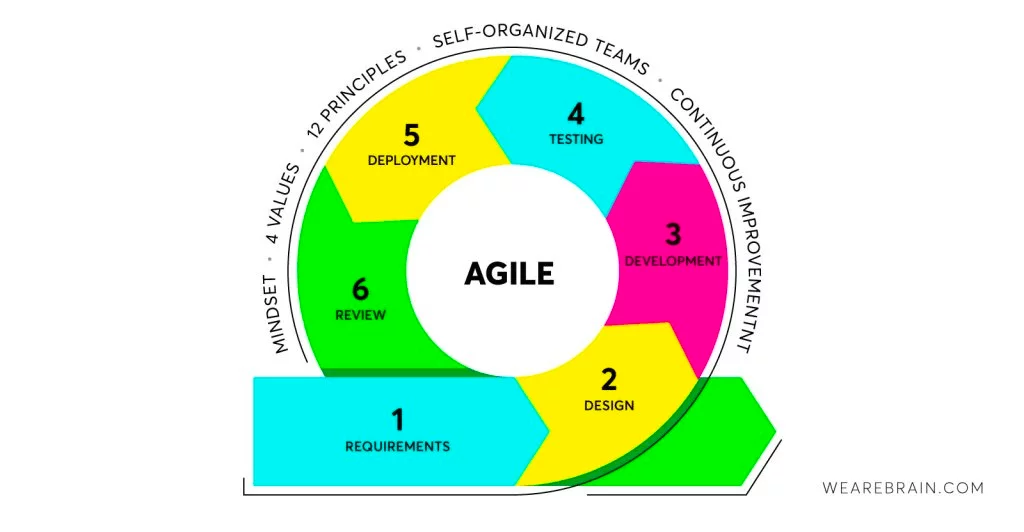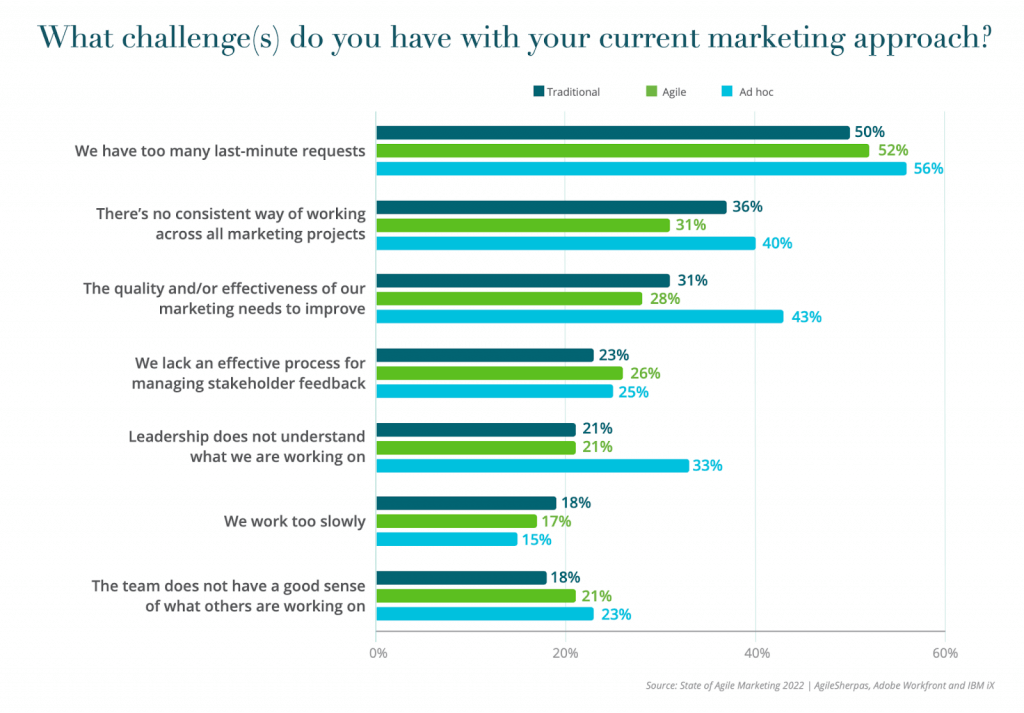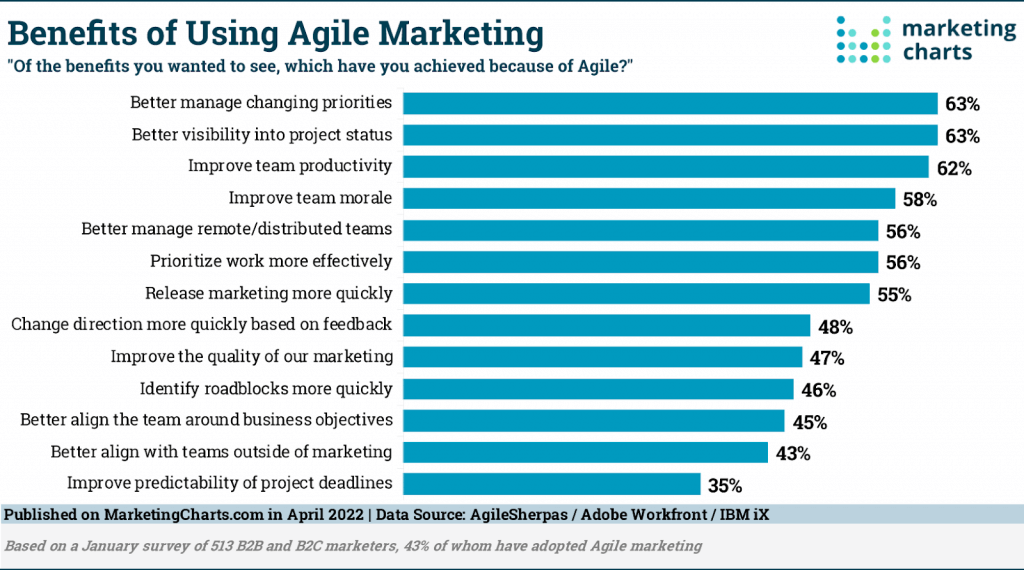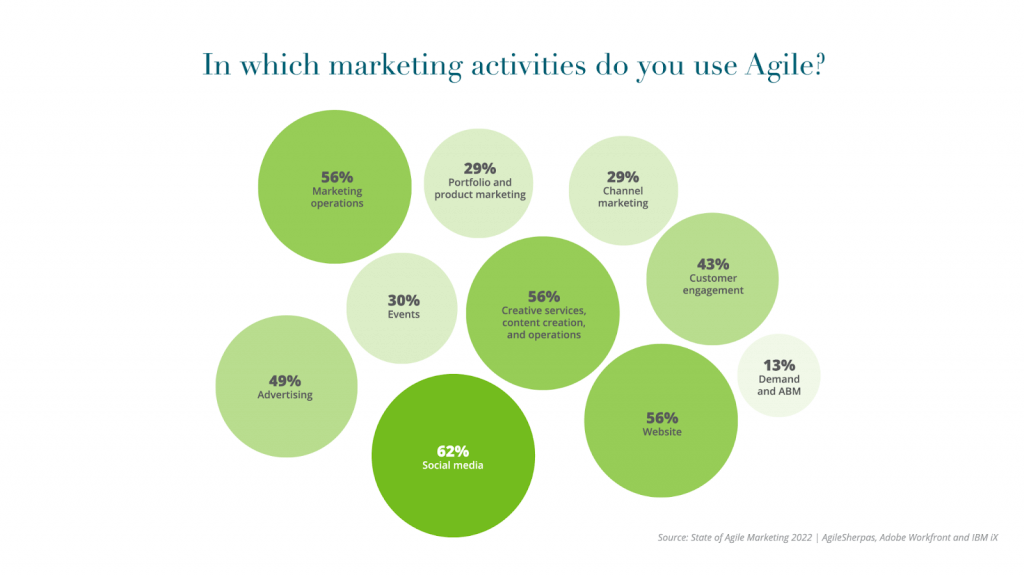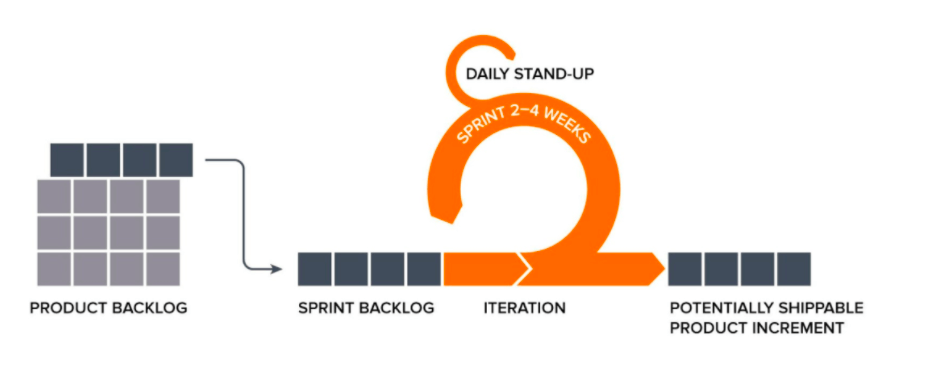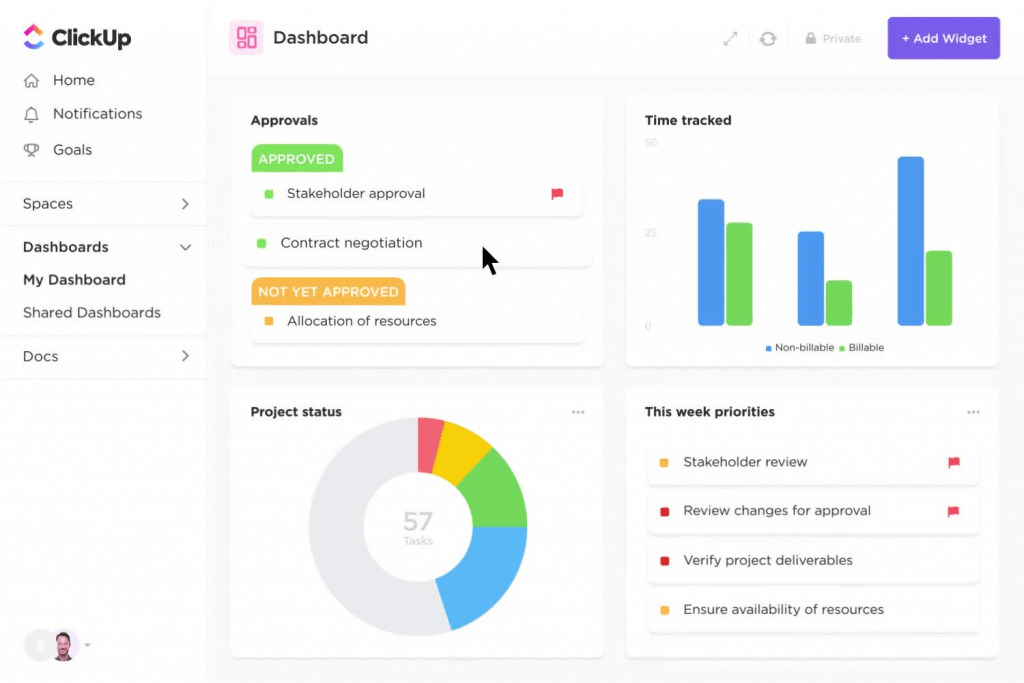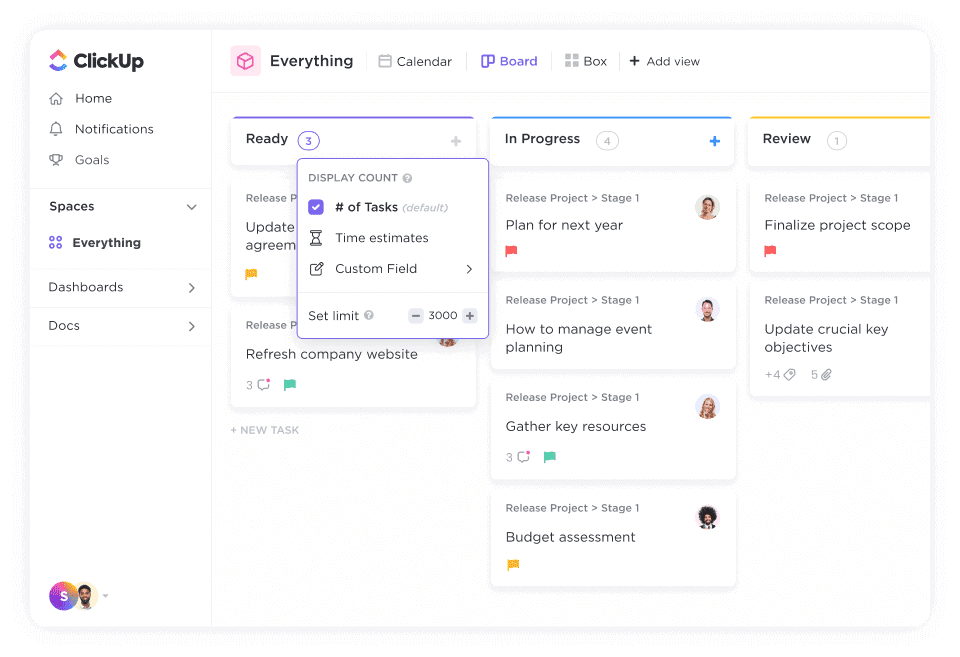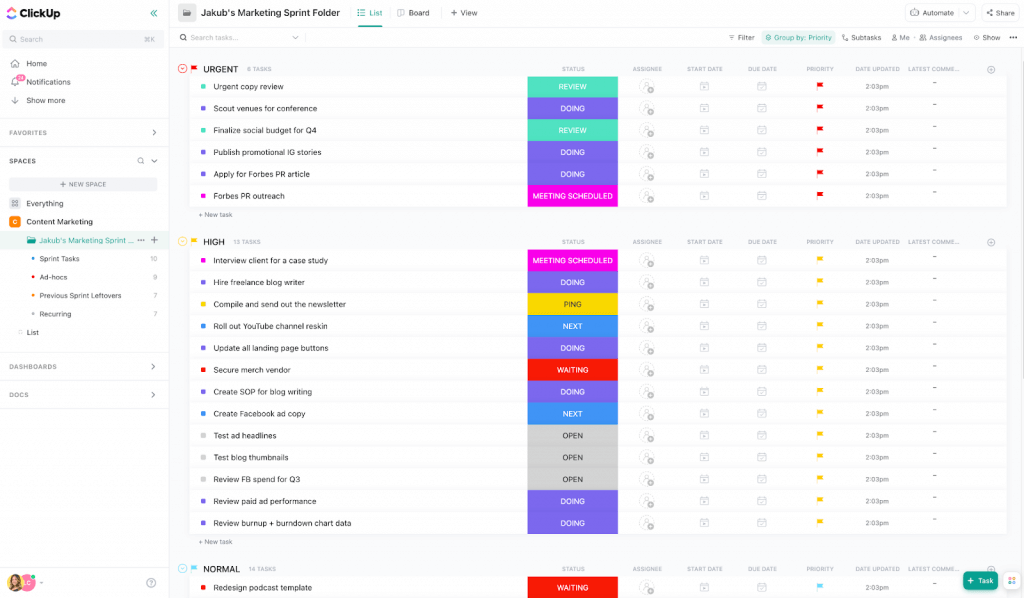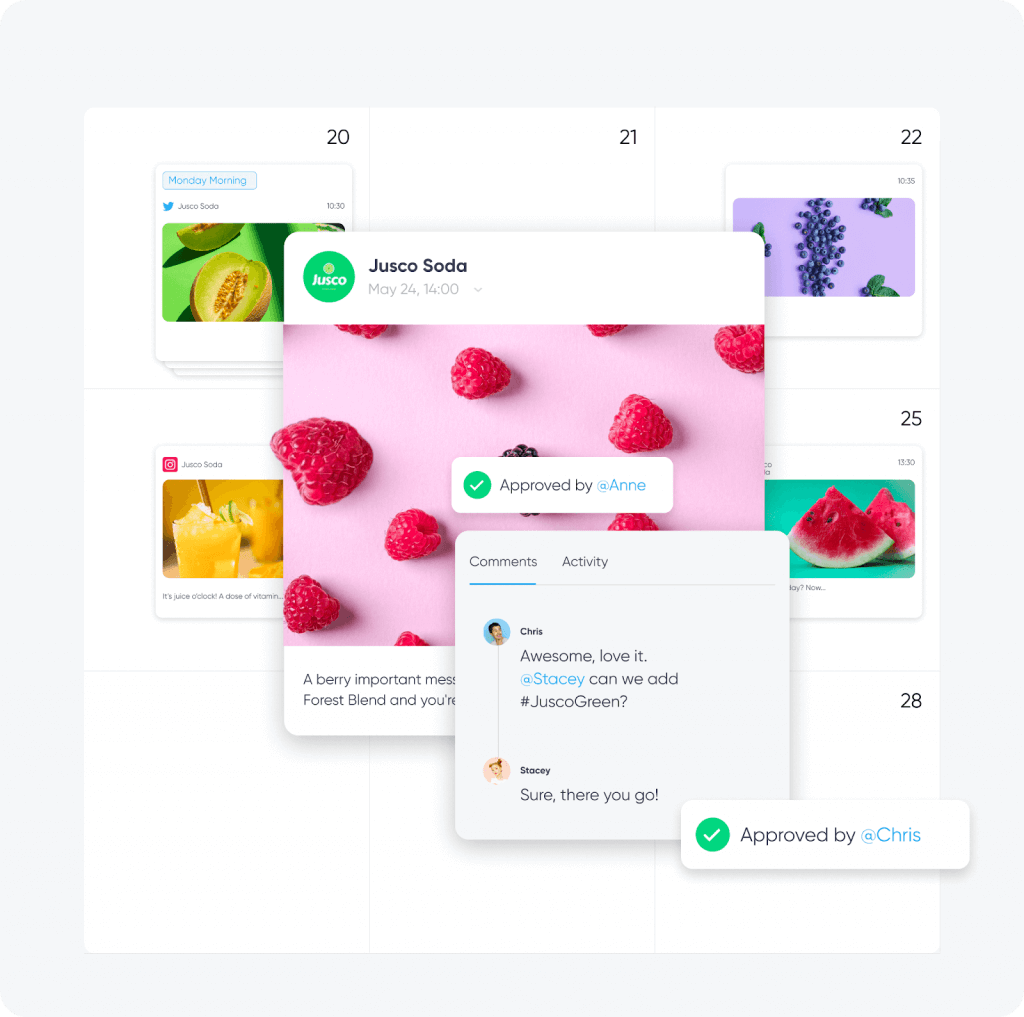If you’re looking for a more efficient way to manage your marketing projects, you may want to consider the Agile marketing methodology.
This approach is based on the principles of Agile software development. It can be an effective way of transforming marketing teams by improving their tactical marketing approach and cross-functional collaboration to deliver high-value projects.
In this article, we’ll dive into the Agile marketing methodology, its benefits, and how you can implement it. We’ll also look at some marketing project management tools that can help manage an agile marketing strategy!
Table of contents:
- What is Agile Marketing?
- 5 Key Values and Principles of the Agile Marketing Manifesto
- Benefits of Agile Marketing
- Potential Drawbacks of Agile Marketing
- How Teams Use Agile Marketing
- How To Set Up and Implement Agile Marketing
- Use Agile marketing software tools to help manage your Agile workflow
What is Agile Marketing?
In the ever-changing digital world, many marketing teams seek a more effective and long-term solution to improve processes, cross-functional collaboration, transparency, and drive measurable results. That’s why Agile marketing methodology has been a hot topic within marketing departments.
Source: wearebrain.com
The Agile marketing methodology focuses on creating a fast and incremental process that encourages feedback from customers and team members to make informed decisions and changes. It harnesses the benefits of the Agile methodology and uses an effective feedback-loop approach to guide your marketing efforts and improve your team’s overall adaptability and alignment.
Just like an Agile software development team, an Agile marketing team works on a project in short bursts, called sprints. At the end of each 2-4 month sprint, the team measures how well the projects did and then works to improve their projects every sprint.
The goal here is to enable your marketing department to work quickly and efficiently in a disciplined and organized way—and without sacrificing quality.
What is the difference between Agile marketing and traditional marketing?
The short answer is that traditional marketing focuses on the four 4 P’s (Price, Placement, Promotion, Product)—all of which the producer can control.
Agile marketing, on the other hand, focuses on the customer’s buying process and believes that customers have various and unique ways of making a buying decision, making them less predictable. Because of this, modern marketers turn to customer feedback, validate learning, and make adaptive iterations to maximize marketing effectiveness.
5 Key Values and Principles of the Agile Marketing Manifesto
The Agile Marketing Manifesto promotes the agile marketing core values that teams must understand and use as a guide to keeping up with the speed and complexity of today’s digital marketing landscape.
Use these five values and principles to guide your marketing efforts:
1. Focus on quality and relevancy over outputs
Focus and prioritize customer and business needs, and create more directed and relevant initiatives (targeted content and offers over various but scattered approaches).
2. Early and continuous delivery
Instead of waiting for everything to be perfect, involve your customers earlier in the cycle to collect customer feedback and promote customer-focused collaboration. Striving for the perfect moment can cause long production cycles and deprive your team of important findings from your target audience.
3. Learn through data and experimentation instead to avoid the downside of the HIPPO effect
Track findings from marketing campaigns and analyze the data to make more informed business decisions versus relying on the opinions of the “highest paid person in the room” (HIPPO). Validate your learning with the implement-measure-learn-feedback loop by running many small experiments versus a few large bets with big-bang campaign testing.
4. Create core values that promote cross-functional collaboration and an agile mindset
Agile marketing requires teams to work together and move faster to produce high-value projects. Team cohesiveness is key to delivering quality work on time and is also an essential element of innovation. Bring diverse minds together to create better campaigns, products, unique experiences, and so on.
5. Ability to respond to change instead of following a static plan
It’s important to respond to change, findings, and customer feedback for continuous improvement. A rigid and static plan doesn’t allow the flexibility to adapt to these factors and can result in missed marketing efforts and under-serving your target audience.
Keep these important values and principles in mind when considering adopting an Agile Marketing approach for your organization. They’re crucial to the success of your implementation, along with understanding the benefits of this methodology below!
Benefits of Agile Marketing
According to Agile Sherpa’s 5th State of Agile Marketing Report in 2022, 91% of non-Agile marketing departments plan to implement Agile within the year ahead.
Why? Here are the most common pain points that many wish to eliminate with this methodology:
Source: Agile Sherpas
If implemented correctly, Agile marketing can help squash your marketing worries and improve many aspects of your workflow. It can help teams hone in focused energy instead of scattered energy to improve work efficiency and quality of work, among many others.
Here are a few pros of implementing an agile marketing methodology in more detail:
Lowers costs and increases ROI
The agile marketing process breaks down your larger marketing projects into smaller chunks of tasks called sprints, which in turn, helps with determining how successful and profitable each sprint is. If a marketing project isn’t as effective as predicted, your team can see where to readjust, or they can simply end the project to save on costs.
Allows experimentation and increases adaptability
Agile marketing embraces failure as part of the process and encourages frequent feedback. With this type of agile mindset, marketing teams focus on identifying what works and what doesn’t and testing out new ideas. This approach enables agile teams to run more adaptive and iterative campaigns since they learn how to respond to new opportunities, trends, and disruptions more efficiently and effectively.
Increases transparency, reducing project risks
Agile marketing gives stakeholders and senior marketing leaders a better project overview. This visibility helps agile marketing teams and stakeholders make better business decisions, which can naturally reduce risks.
Boosts employee productivity
The goal of every agile marketing team is to maximize work efficiency. Agile marketing allows them to work on only the task at hand instead of handling multiple parts of the project at once, increasing focus and efficiency.
The list doesn’t end here! See the other reported benefits below—do any of them resonate with your goals? If so, then it may be your sign to adopt an Agile approach!
Caption: Via Marketincharts.com (April 2022)
Potential Drawbacks of Agile Marketing
While an Agile approach can improve many aspects of your business and team’s workflow, it’s still worth considering if implementing agile practices is suitable in your case.
Here are a few potential disadvantages of Agile Marketing:
Requires a higher level of team collaboration
First, agile marketing requires teams to move faster. And when working with cross-functional teams, you’ll need strong team alignment and collaboration to keep things moving in the right direction.
However, this could be tricky since agile demands a considerable amount of commitment from all team members involved in the project to succeed. Even one person can cause delays or project bottlenecks. Your team may experience issues related to task or project visibility, missed deadlines, etc.
Solution: Incorporate scrum boards to give your team a clear visual of your project statuses and view important details related to your Sprints. Assign a designated scrum master to help ensure the scrum framework is followed for maximum efficiency and optimal workflow.
Scope Creep
Because an Agile marketing approach promotes a “continuous improvement” philosophy while moving faster than traditional marketing approaches, chances for last-minute changes and additions are higher.
This is known as scope creep, where a project’s requirements and deliverables increase as the project progresses.
When scope creep occurs, managing resources such as time and people can become an issue, leading to a higher chance of project failure and extra pressure on your team, causing burnout.
Solution: Create a knowledge base for your team using this software, that outlines the processes to ensure consistency and adds boundaries to your projects.
How Teams Use Agile Marketing
The Agile marketing report from Sherpa also revealed the most common marketing functions teams implement Agile methodologies to meet modern marketing demands.
Take a look at the image below:
Source: Agile Sherpas
Based on the findings in this report, it’s evident that Content Marketing and Creative (56%) and Social Media (62%) teams have been some of the biggest adopters of the Agile marketing methodology.
A content marketing team can use the agile methodology to create something faster but also allow them to learn more from the performance of their content. They can then take those findings and continue optimizing content—the same applies to any social media and creative team.
Agile methodologies and marketing fundamentals provide the agility needed in these responsive roles and allow them to move faster to keep up with industry developments. Modern marketing teams have turned to digital work tools to help manage their agile workload and use Marketing sprint templates to create consistent workflows.
As a result, cross-functional teams can expect to improve the quality of their content, boost work efficiency, stay within timelines and budget, and develop adaptability skills.
How To Set Up and Implement Agile Marketing
To promote an agile mindset and ease the transition, you must first organize work and restructure a few key parts of your projects.
Before we dive into it, let’s quickly go over a few key Agile marketing-related terms to help you better understand the following sections!
- Sprints: A short period (usually 1-4 weeks) when an Agile team works together to complete a pre-set amount of work to complete within the targeted time frame.
- User Stories: Provides insight into the personas associated with each target market
- Epics: Large chunks of work that can be broken down into smaller, more manageable user stories or tasks.
- Scrum: Most common Agile framework – projects are broken down into smaller chunks.
-
- Scrum master: A dedicated person on your agile marketing team that schedules and runs daily stand-up meetings.
- Daily stand-up meetings: Short meetings dedicated to sharing updates, identifying bottlenecks and solutions for improvements, and goal alignment.
- Kanban: Focuses on completing tasks in the backlog and constantly improving performance. It uses visual cues to track project progress.
- Burndown charts: Used by Agile project managers to keep track of the amount of work invested and the time remaining to complete the project.
- Product backlog: A list of everything you need to work on a project, such as the deliverables for a business project.
- Product owner: Person in charge of creating and maintaining the backlog.
Now that you’ve seen some key terms in Agile marketing, it’s time to learn how to implement Agile marketing methodologies with your team!
Here are a few steps to follow to help your team prepare for the transition and hit the ground running:
1. Sprint Planning Meeting: Prep your Agile team and ensure team alignment
Agile teams in software typically consist of developers, product managers, marketers, designers, and operation managers. Since there are many different teams involved, it’s critical to establish alignment among everyone involved in the project right from the start — it’s time to expand your team of executives; as for mentoring your development team, you need to find a technical co-founder who will carry all technical aspects and to kick things off with a Sprint planning meeting.
- Set up a meeting with your team to ensure everyone is on the same page
- Discuss each team member’s roles and responsibilities and make sure they understand the goals and objectives of Agile marketing
- Align your team’s work capacity to ensure your resources are accurate and to avoid underestimation
Understanding your team’s work capacity will help you plan your business goals and objectives and the resources of your marketing departments more effectively.
2. Goal Setting: Set measurable goals and objectives
Create a strong marketing strategy by setting SMART goals, KPIs, and OKRs tied deeper to business results. The critical point here is to create a solid outcome-driven agile marketing team with a strategic vision.
Here are a couple of examples for reference:
- Social media engagement: Increase Instagram followers by 15% from Q3 to Q4
- Conversion rates: Increase conversion rate from MQL (marketing-qualified lead) to SQL (sales qualified lead) from 25-30% from Q2 to Q3
OKRs are deeply tied to business results, so a happy blend of Agile marketing and OKRs help make the marketing process more outcome-driven and allows your agile team to retain strategic focus.
3. Plan your Sprint backlog and break down the work
Sprints in Agile marketing usually run one to four weeks at a time, helping improve focus and work efficiency since teams work shorter bouts.
Before your team can start working in Sprints, it’s important to set the marketing backlog and place the items with the highest priority at the top of the list.
Once your product owner and the agile team have an organized backlog or a list of prioritized tasks, then it’s time to determine how the work will be distributed among team members.
The most optimal way to visualize your sprint backlog is to use an online Scrum or Kanban board. Using a Kanban board will allow your team to see clearly what status each task is currently in (To-Do, In Progress, Done). This is especially useful if your team has members that are visual learners; a Kanban board will help cater to their learning style.
4. Round up your team for a huddle to improve communication and alignment with stand-up meetings
To check the status of each project and see how they’re progressing, your marketing teams should huddle for daily stand-up meetings. The goal of the meeting is to get updates, uncover any bottlenecks and blockers, and synchronize with your team to determine if they’re on track to complete their Sprint goals.
Via agilesherpas.com
5. Measure progress and focus on continuous improvement
Once the sprint has been completed, the next step is to check how your Agile marketing team performed.
One way to visualize important Agile metrics such as work efficiency, cycle time, and throughput is to set up an automated dashboard via a project management tool.
One of the project management and collaboration tools worth considering is ClickUp. It has a highly-intuitive and fully customizable Dashboard feature that offers over 50+ widgets to help you and your team get instant insight and data about your work.
Via ClickUp
Use Agile marketing software tools to help manage your Agile workflow
Agile marketing is a process that allows for more flexibility and creativity when it comes to the creation and execution of marketing campaigns. However, to make agile marketing work, you need the right tools for campaign management.
These tools can help you optimize your work process and improve communication between team members, as well as help your team stay organized and on track—this is essential when working in a fast-paced environment.
Now let’s explore a couple of powerful tools for content management that can help you do just that.
Visualize your marketing team’s workflow, manage sprints, and ship faster with ClickUp
ClickUp is an all-in-one project management software that offers hundreds of fully customizable features to help teams across different industries streamline their workflow, boost work efficiency, and manage any type of work, including your marketing projects.
With this project management software, your team can choose to view your tasks in 15+ ways, including a Kanban view, Gantt view, and Box view, which help manage Agile marketing workflows.
The Kanban view or Board view will enable your team to visualize Agile workflows clearly, making it easier to identify bottlenecks quicker and limit work in progress to keep projects on track. This view allows you to set boards by status, due dates, priority, and so much more to keep your team aligned and updated at all times.
Build a flexible Kanban system to visualize your work and improve project management with ClickUp’s Board view
And since Agile marketing is all about optimizing processes, modern Agile marketers can take advantage of the ready-to-use and customizable templates in ClickUp to create consistent and repeatable resources to give every sprint cycle a functional structure.
Via ClickUp
Other key ClickUp features for Agile marketing teams:
- Goals: Set goals and track key results with tasks, numerical values, or true/false
- Milestones: Turn tasks into progress markers to identify key points in a project. Doing this with a workflow management software helps projects and to-do lists get done.
- Docs: Document bugs, collaborate on ideas, capture meeting minutes, create roadmaps, and other visual knowledge bases
- Automation: Save time by automating processes such as assigning tasks, moving statuses, changing assignees, and more. Simply set triggers and actions, and save the automation to move your workflow, hands-free
- Multiple Assignees: Add multiple assignees to a task to clearly show who owns and is responsible for each task or project
- Custom Fields: Create Custom Fields to ensure important details are listed; add priorities, tags, progress bars, and more to keep your team on track and your sprints on schedule
- Task Checklists: Create a consistent process by adding acceptance criteria and sprint lists to a task, and check each action item off as they are completed
Improve your social media marketing team’s collaboration and get content approved quicker with Planable
Planable is an end-to-end workflow tool for social media teams, agencies, freelancers, and other marketing teams to create social media campaigns and exchange feedback most visually and effectively.
This tool allows your team to plan and visualize social media feeds before posting and offers four ways to view your content, including a sleek social media calendar view, to help improve brand storytelling and to keep teams and clients aligned on publishing dates.
For an efficient client-feedback process, simply invite team members and clients to collaborate, exchange feedback, and review internal notes in real time, making the approval workflow easier and faster.
Via Planable
Using Planable to streamline your social media team’s content approval processes will surely help your entire marketing team move faster, ship more content, and remain right on schedule—at all times.
Time to Get Agile With ClickUp and Planable
Every agile marketing implementation looks a little different for every marketing team. Team members may have different workflow preferences and learning styles, and every team has different business needs that require different processes.
With this in mind, you’ll need to do a deep evaluation of your team’s current workflow and determine if an Agile marketing approach will be beneficial to your business before diving into it. Refer back to some of the pros and cons listed above to help you decide. Though there may be a few disadvantages to using the Agile marketing methodology, the right tools can help eliminate those issues and set your team up for success.
ClickUp, for one, can help improve team collaboration, ease sprint planning, align teams on goals, and visualize progress with Agile dashboards—making every step of your Agile marketing process seamless and manageable. And once you’ve streamlined your sprint planning, your marketing teams can templatize their sprint tasks to ensure consistency and create a scalable process.
As for social media management, Planable can reduce the back-and-forth and time-sucking feedback loop by providing a simple approval workflow process, making social media content planning much easier and enjoyable for both internal teams and clients. Not to mention, this tool helps move content along quicker and helps marketing teams deliver more content—on time.
With the rise of digital marketing tools and Agile methodology, businesses can reach more customers than ever before. And with so many changes in technology and how people consume information, it’s more important than ever to have a strategic and nimble marketing approach—an Agile marketing approach and the proper tools can help your team execute like pros.





